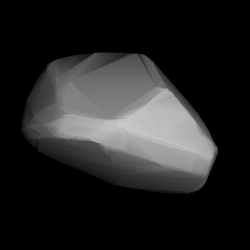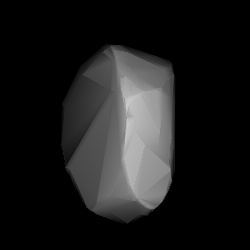Related Research Articles
4349 Tibúrcio, provisional designation 1989 LX, is a dark asteroid from the central region of the asteroid belt, approximately 29 kilometers in diameter. It was discovered on 5 June 1989, by German astronomer Werner Landgraf at ESO's La Silla Observatory in northern Chile.
2023 Asaph, provisional designation 1952 SA, is a dark asteroid from the outer regions of the asteroid belt, approximately 21 kilometers in diameter. It was discovered on 16 September 1952, by astronomers of the Indiana Asteroid Program at Goethe Link Observatory in Indiana, United States.
3204 Lindgren, provisional designation 1978 RH, is a carbonaceous background asteroid from the outer regions of the asteroid belt, approximately 20 kilometers in diameter. It was discovered on 1 September 1978, by Soviet astronomer Nikolai Chernykh at the Crimean Astrophysical Observatory in Nauchnij, on the Crimean peninsula. The B-type asteroid has a rotation period of 5.6 hours. It was named after Swedish writer Astrid Lindgren.

9936 Al-Biruni, provisional designation 1986 PN4, is a carbonaceous asteroid from the outer region of the asteroid belt, approximately 24 kilometers in diameter. It was discovered on 8 August 1986, by Belgian and Bulgarian astronomers Eric Elst and Violeta Ivanova at the Rozhen Observatory, located in Bulgaria's Smolyan province near the border to Greece. It was named for Persian medieval scholar Al-Biruni.
3724 Annenskij, provisional designation 1979 YN8, is a stony Gefionian asteroid from the central regions of the asteroid belt, approximately 14 kilometers (9 miles) in diameter. It was discovered on 23 December 1979, by Soviet astronomer Lyudmila Zhuravleva at the Crimean Astrophysical Observatory in Nauchnij, on the Crimean peninsula. The S-type asteroid has a rotation period of 3.97 hours. It was named for Russian poet Innokenty Annensky.

3544 Borodino (prov. designation: 1977 RD4) is a stony background asteroid from the inner regions of the asteroid belt, approximately 9 kilometers (5.6 miles) in diameter. It was discovered on 7 September 1977, by Soviet astronomer Nikolai Chernykh at the Crimean Astrophysical Observatory in Nauchnij, on the Crimean peninsula. The likely elongated S-type asteroid has a rotation period of 5.44 hours. It was named for the Russian village of Borodino where the Battle of Borodino took place.

1555 Dejan, provisional designation 1941 SA, is an asteroid from the background population of the central regions of the asteroid belt, approximately 22 kilometers in diameter. It was discovered on 15 September 1941, by Belgian astronomer Fernand Rigaux at the Royal Observatory of Belgium in Uccle. The asteroid was named after Dejan Đurković, son of Serbian astronomer Petar Đurković.
2126 Gerasimovich, provisional designation 1970 QZ, is a stony background asteroid from the inner regions of the asteroid belt, approximately 8 kilometers in diameter. It was discovered on 30 August 1970, by Soviet astronomer Tamara Smirnova at the Crimean Astrophysical Observatory in Nauchnyj, on the Crimean peninsula. The asteroid was named after Russian astronomer Boris Gerasimovich.
2324 Janice, provisional designation 1978 VS4, is a dark background asteroid from the outer regions of the asteroid belt, approximately 25 kilometers (16 miles) in diameter. It was discovered on 7 November 1978, by American astronomers Eleanor Helin and Schelte Bus at the Palomar Observatory in California. The asteroid was named for Janice Cline at Caltech. The presumably C-type asteroid has a rotation period of 23.2 hours.
5385 Kamenka, provisional designation 1975 TS3, is a background asteroid from the outer regions of the asteroid belt, approximately 16 kilometers (10 miles) in diameter. It was discovered on 3 October 1975, by Soviet astronomer Lyudmila Chernykh at the Crimean Astrophysical Observatory in Nauchnij, on the Crimean peninsula. The presumed C-type asteroid has a rotation period of 6.68 hours. It was named for the Ukrainian town of Kamianka.

1836 Komarov is a carbonaceous Dorian asteroid from the central region of the asteroid belt, approximately 22 kilometers in diameter. It was discovered on 26 July 1971 by Russian astronomer Nikolai Chernykh at Crimean Astrophysical Observatory in Nauchnij on the Crimean peninsula. It was named after Soviet cosmonaut Vladimir Komarov.
4944 Kozlovskij, provisional designation 1987 RP3, is a carbonaceous Witt asteroid from the central regions of the asteroid belt, approximately 10 kilometers (6 miles) in diameter. It was discovered on 2 September 1987, by Soviet astronomer Lyudmila Chernykh at the Crimean Astrophysical Observatory in Nauchnij, on the Crimean Peninsula. The asteroid was named for Russian opera singer Ivan Kozlovsky.
6255 Kuma, provisional designation 1994 XT, is a carbonaceous asteroid from the central region of the asteroid belt, approximately 22 kilometers in diameter. It was discovered on 5 December 1994, by Japanese astronomer Akimasa Nakamura at Kuma Kogen Astronomical Observatory on the Island of Shikoku, Japan. It was named after the Japanese town of Kumakōgen.
2173 Maresjev, provisional designation 1974 QG1, is a dark background asteroid from the outer regions of the asteroid belt, approximately 28 kilometers (17 miles) in diameter. It was discovered on 22 August 1974, by Soviet–Ukrainian astronomer Lyudmila Zhuravleva at the Crimean Astrophysical Observatory in Nauchnij, on the Crimean peninsula. It was named for Soviet war veteran Alexey Maresyev. The assumed C-type asteroid has a tentative rotation period of 11.6 hours.

4547 Massachusetts is a dark background asteroid from the central regions of the asteroid belt, approximately 24 kilometers in diameter. It was discovered on 16 May 1990, by Japanese astronomers Kin Endate and Kazuro Watanabe at the JCPM Sapporo Station on the island of Hokkaido, Japan. The asteroid was named for the U.S. state of Massachusetts.
4804 Pasteur, provisional designation 1989 XC1, is a carbonaceous background asteroid from the central regions of the asteroid belt, approximately 20 kilometers in diameter. It was discovered on 2 December 1989, by Belgian astronomer Eric Elst at the ESO's La Silla Observatory in Chile. The asteroid was named after French chemist and microbiologist Louis Pasteur.
3184 Raab, provisional designation 1949 QC, is a dark background asteroid and a potentially slow rotator from the central regions of the asteroid belt, approximately 17 kilometers in diameter. It was discovered on 22 August 1949, by South African astronomer Ernest Leonard Johnson at the Union Observatory in Johannesburg. The likely C-type asteroid could have a long rotation period of 275 hours. It was named after Austrian amateur astronomer and software engineer Herbert Raab.

2111 Tselina is a stony Eos asteroid from the outer regions of the asteroid belt. It was discovered on 13 June 1969, by Soviet astronomer Tamara Smirnova at Crimean Astrophysical Observatory in Nauchnij, on the Crimean peninsula. The S-type asteroid has a rotation period of 6.6 hours and measures approximately 23 kilometers in diameter. It was later named after the Soviet Virgin Lands Campaign.

2120 Tyumenia is a dark background asteroid, approximately 45 kilometers in diameter, located in the outer regions of the asteroid belt. It was discovered on 9 September 1967, by Soviet astronomer Tamara Smirnova at the Crimean Astrophysical Observatory in Nauchnyj, on the Crimean peninsula. The asteroid was named for the now Russian district of Tyumen Oblast in Western Siberia.
2862 Vavilov, provisional designation 1977 JP, is a stony background asteroid and exceptionally slow rotator from the inner regions of the asteroid belt, approximately 7 kilometers in diameter. It was discovered on 15 May 1977, by Soviet astronomer Nikolai Chernykh at the Crimean Astrophysical Observatory in Nauchnij, on the Crimean peninsula. The asteroid was named after Russian plant geneticist Nikolai Vavilov and his physicist brother Sergey Ivanovich Vavilov.
References
- 1 2 3 4 5 6 7 "3406 Omsk (1969 DA)". Minor Planet Center. Retrieved 14 May 2018.
- 1 2 3 4 5 6 "JPL Small-Body Database Browser: 3406 Omsk (1969 DA)" (2017-10-30 last obs.). Jet Propulsion Laboratory . Retrieved 14 May 2018.
- 1 2 "Asteroid 3406 Omsk – Proper Elements". AstDyS-2, Asteroids – Dynamic Site. Retrieved 29 October 2019.
- 1 2 3 4 Masiero, Joseph R.; Mainzer, A. K.; Grav, T.; Bauer, J. M.; Cutri, R. M.; Nugent, C.; et al. (November 2012). "Preliminary Analysis of WISE/NEOWISE 3-Band Cryogenic and Post-cryogenic Observations of Main Belt Asteroids". The Astrophysical Journal Letters. 759 (1): 5. arXiv: 1209.5794 . Bibcode:2012ApJ...759L...8M. doi:10.1088/2041-8205/759/1/L8. S2CID 46350317.
- 1 2 3 4 5 6 7 8 "LCDB Data for (3406) Omsk". Asteroid Lightcurve Database (LCDB). Retrieved 14 May 2018.
- 1 2 3 4 Tedesco, E. F.; Noah, P. V.; Noah, M.; Price, S. D. (October 2004). "IRAS Minor Planet Survey V6.0". NASA Planetary Data System. 12: IRAS-A-FPA-3-RDR-IMPS-V6.0. Bibcode:2004PDSS...12.....T . Retrieved 22 October 2019.
- 1 2 Masiero, Joseph R.; Mainzer, A. K.; Grav, T.; Bauer, J. M.; Cutri, R. M.; Dailey, J.; et al. (November 2011). "Main Belt Asteroids with WISE/NEOWISE. I. Preliminary Albedos and Diameters". The Astrophysical Journal. 741 (2): 20. arXiv: 1109.4096 . Bibcode:2011ApJ...741...68M. doi:10.1088/0004-637X/741/2/68. S2CID 118745497.
- 1 2 3 4 5 6 Mainzer, A.; Grav, T.; Masiero, J.; Hand, E.; Bauer, J.; Tholen, D.; et al. (November 2011). "NEOWISE Studies of Spectrophotometrically Classified Asteroids: Preliminary Results". The Astrophysical Journal. 741 (2): 25. arXiv: 1109.6407 . Bibcode:2011ApJ...741...90M. doi:10.1088/0004-637X/741/2/90. S2CID 35447010. (catalog)
- 1 2 3 4 Usui, Fumihiko; Kuroda, Daisuke; Müller, Thomas G.; Hasegawa, Sunao; Ishiguro, Masateru; Ootsubo, Takafumi; et al. (October 2011). "Asteroid Catalog Using Akari: AKARI/IRC Mid-Infrared Asteroid Survey". Publications of the Astronomical Society of Japan. 63 (5): 1117–1138. Bibcode:2011PASJ...63.1117U. doi: 10.1093/pasj/63.5.1117 . (online, AcuA catalog p. 153)
- 1 2 Bembrick, Collin; Crawford, Greg (December 2007). "The Rotation Period of 3406 Omsk". The Minor Planet Bulletin. 34 (4): 128–129. Bibcode:2007MPBu...34..128B. ISSN 1052-8091.
- 1 2 3 Veres, Peter; Jedicke, Robert; Fitzsimmons, Alan; Denneau, Larry; Granvik, Mikael; Bolin, Bryce; et al. (November 2015). "Absolute magnitudes and slope parameters for 250,000 asteroids observed by Pan-STARRS PS1 - Preliminary results". Icarus. 261: 34–47. arXiv: 1506.00762 . Bibcode:2015Icar..261...34V. doi:10.1016/j.icarus.2015.08.007. S2CID 53493339.
- ↑ "MPC/MPO/MPS Archive". Minor Planet Center. Retrieved 14 May 2018.